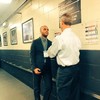Photo by Jeffrey Swinger - USA TODAY Sports
Brandon Ingram’s first step makes whoever's guarding him feel like it’s Monday morning. Ingram’s long legs allow his upper body to float past those who (think they) are well positioned to keep him at bay.He rocks his man into a brief but effective coma by cradling the ball in his right hand—momentarily injecting the fear of a pull-up jumper deep into their heart—before whizzing towards the basket.On Thursday night against the Philadelphia 76ers, Ingram had his way. Here he is blowing by Timothe Luwawu-Cabarrot with a fierce left to right crossover in semi-transition:And here's Ingram forcing Amir Johnson to physically impede his progress in a way that the NBA’s rulebook won't allow.But when Ingram tried the exact same progression against Ben Simmons, whose unparalleled vision and pogo-stick athleticism have fans of the Philadelphia 76ers already envisioning a Hall of Fame ceremony, there was a noticeably different result.There have been many revelations in the NBA this year (Ingram among them), but arguably none can match the long-term effect of Simmons turning into one of the league’s best defenders. Two months into his career, he ranks first in Defensive Real Plus-Minus at his position (which is point guard, even though he spends time all over the place) and 15th overall.According to Cleaning the Glass, the 76ers allow 7.3 more points per 100 possessions when Simmons is on the bench, a significant yet messy number that doesn’t account for the fact that he spends a ton of time beside Joel Embiid and Robert Covington—two All-Defensive team shoe-ins—and when Simmons isn’t with Embiid Philly’s defense really struggles.Any attempt to untwist these numbers is impossible and useless so early in a season, let alone a career, but when Simmons is engaged—as he was in pinning Ingram’s shot against the backboard—there are few players his age in recent NBA history who’ve been able to impact games the way he does on the defensive end while still serving as the primary ball-handler for an above-average offense.The Sixers are high on all the various things he can do, believing he’ll eventually rise to become an elite defensive presence. But there are still lapses in focus that—while understandable given his inexperience, immense offensive responsibly, and the fact that Philly sometimes matches him up with smaller, faster ball-handlers—are avoidable. It’s unknown whether those drawbacks will either course correct or worsen with age, but, right now, they're at the very least hard to completely ignore.Here's a good example: Simmons completely loses track of T.J. Warren after he scores a basket, never getting into defensive position or even looking for his man.Simmons has spent plenty of time tracking point guards through on and off-ball screens, a task that’s borderline impossible for anyone who's 6’10”, and much like other nominal forwards who often assume that taxing challenge while balancing the need to set teammates up on the other end (like, you know, LeBron James), Simmons tends to die on screens and pass off his man in a switch with whichever one of his teammates is on the screener.This is more of a problem against the Golden State Warriors and Steph Curry than it is against the Los Angeles Clippers and Austin Rivers, but is also something he needs to work on. We're nitpicking, though. Even attempting to pull something like this off is worth a round of applause, and it speaks to Simmons’ rare physical tools. He unlocks lineups that allow the Sixers to put him on just about anybody, without fear of there being a significant disadvantage when he switches.He isn’t strong enough to take on someone like Marcin Gortat for an entire game, but every now and then he’ll find himself guarding an ox down low, and the Sixers won’t have to compromise other parts of the floor by sending help his way.His 2.2 steals per game is second in the league, and he ranks ninth in steal percentage. An absolute hawk who lives inside passing lanes, the Sixers hum when Simmons is plopped onto a non-shooter who allows him to roam around the floor, creep up on ball-handlers, and wreak havoc in ways that lead to easy transition opportunities.What we've seen so far is only a snapshot of who he'll eventually be, but the early returns on Simmons' defense are significant enough to elevate their long-term ceiling as a potential dynasty.
Advertisement
Advertisement
